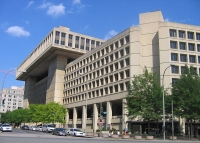
Officially named the J. Edgar Hoover FBI Building, after its notorious long-time director, this rather ugly concrete structure is headquarters of the Federal Bureau of Investigation.The FBI Experience, a self-guided tour, is open to the public and explores the Bureau's past and current work to protect the nation. The tour takes visitors through the Material Analysis Unit and crime laboratories where fingerprinting, DNA, and ballistics testing takes place; past displays of thousands of confiscated weapons and illegal items seized during narcotics operations; exhibits on crime fighting techniques and counterintelligence operations; as well as other presentations on terrorism, agent training, some famous cases, and photographs of the FBI's 'Ten Most Wanted List'.Due to security reasons, the tours are only available to U.S. citizens or valid green card holders. Visitors must request a visit to the Bureau from their congressional representative. The tour must be booked at least 4 weeks in advance and visitors must be given FBI clearance to enter the building. Those in search of espionage history, however, should go to the nearby International Spy Museum.
Address : 935 Pennsylvania Avenue
Website : www.fbi.gov
Transport : Federal Triangle metro station
Opening times : Monday to Friday 9am-3pm.
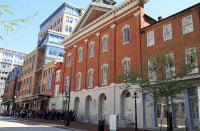
On April 14th, 1865, President Abraham Lincoln was assassinated while watching a performance at Ford's Theatre in Washington, DC. His killer, an actor named John Wilkes Booth who sympathised with the Confederates in the ongoing Civil War, then jumped to the stage and shouted 'Sic simper tyrannis' (Thus to all tyrants) before fleeing the theatre. The US Government bought the theatre and prohibited it from use as an amusement venue. It was used for various storage and clerical purposes until it was restored and reopened for performances in 1968. Today, Ford's Theatre is both an active performance venue and historical site, the Ford's Theatre Museum containing artefacts related to the assassination, including the Derringer pistol Booth used. Across from the theatre is the Petersen House, which is where President Lincoln finally died early the next morning.A tour of the entire site lasts about 2 hours, lasting about an hour and limited to groups of 20 people at a time. Tours should be booked in advance to avoid disappointment. Visitors must be sure to check out the website to see what is currently on stage.
Address : 511 10th Street NW
Website : www.fordstheatre.org
Telephone : (202) 347-4833
Opening times : Opening times vary day to day - check the website for details.
Admission : Ticket prices vary for tours, performances and museum admission. See official website for details.
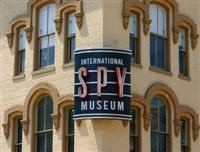
One of Washington's newest museums, the International Spy Museum features the largest collection of publicly displayed international espionage artefacts in the world. It is the result of years of planning and advice by former officials of the CIA, FBI, and KGB, as well as some of the nation's top experts in intelligence. It aims to educate the public about espionage and its significant impact on historic and current events.Interactive exhibits cover the history of spying, famous spies, spying during the World Wars with an exhibit on unheeded intelligence that warned of the Pearl Harbour attack, sophisticated espionage techniques of the Cold War, and the latest spy trends and challenges of 21st century espionage. There is also a section dealing with high-tech gadgets such as bugs, tiny cameras and ingenious disguise techniques, with interactive stations exploring surveillance, disguises, code breaking, threat analysis, and more.There are several interactive exhibits, including Operation Spy and Spy in the City that allow visitors to try their hand at spying; hands-on activities include safe-cracking and conducting polygraph tests, experiences which are combined with special effects and live action. The museum complex includes a restaurant, spy-theme café, and shop.
Address : 800 F Street NW
Website : www.spymuseum.org
Telephone : (202) 393 7798
Transport : Gallery Place/Chinatown or National Archives/Navy Memorial metro stations
Opening times : Open daily from 9am to 7pm.
Admission : $23 adults, $15 youths aged 7 - 11, free for children under six. Other concessions available.
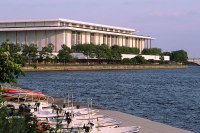
One of the most prestigious performing arts centres in the US, the John F. Kennedy Center for the Performing Arts is also its busiest, hosting roughly 2,000 performances each year for an audience totalling nearly two million people in its eight separate performance halls. It is home to the National Symphony Orchestra, and has commissioned hundreds of new works in various disciplines, including theatre, dance, jazz, popular, chamber, and folk music. The centre was first conceived by Eleanor Roosevelt as a way to employ actors during World War II, and opened in 1971 with the premiere of Leonard Bernstein's Mass. Each year five artists or groups are awarded the Kennedy Center Honors for lifetime contribution to American culture and the performing arts in a gala ceremony televised nationally.There are a number of interesting tour options for those who don't have the time or money to take in a performance.
Address : 2700 F Street NW
Website : www.kennedy-center.org
Telephone : (202) 467 4600
Transport : Metrorail Orange or Blue line to Foggy Bottom/George Washington University Station. Metro bus #80 stops at the Kennedy Center.
Opening times : Tours depart roughly every 10 minutes. Building opens daily at 10am.
Admission : Tours are free, ticket prices for performances vary.
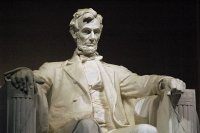
The grandiose Lincoln Memorial is a tribute to the 16th US president, who preserved the Union during the Civil War and ended slavery. It also serves as a Civil War memorial, symbolising the ideas of Freedom and American Democracy. The classical architecture modelled on a Greek temple, is intended to evoke the ideals of the Ancient Greeks, the first modern culture to have rule democratically. In the centre of the memorial, surrounded by 36 white columns representing the 36 states in Lincoln's Union, is a huge marble statue of Abraham Lincoln who stares out over the Reflecting Pool towards the Washington Monument and Capitol Hill. Carved in the walls of the memorial chamber around the statue are inscriptions of two of his most famous speeches, the Gettysburg Address and his Second Inaugural Address, and above each is a painted symbolic mural.The memorial is the site of numerous demonstrations committed to justice, most notably the Civil Rights March in 1963 when Martin Luther King delivered his classic 'I Have a Dream' speech. A bookshop and museum, detailing a photographic history of famous events that occurred on the steps, are nearby.
Address : 2 Lincoln Memorial Cir NW
Website : www.nps.gov/linc
Telephone : (202) 426 6841 (park information)
Transport : Foggy Bottom metro station
Opening times : Open daily 24 hours.
Admission : Free.
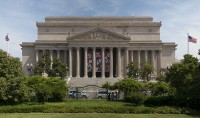
While looking at historical papers may sound dull compared to some of Washington DC's more 'fun' museums, the National Archives is one of the most popular attractions in the city, housing priceless documents from US history, including the Declaration of Independence, the Bill of Rights, the Constitution, the Emancipation Proclamation, and even the 1297 version of the Magna Carta. All these documents are displayed to the public in the Rotunda for the Charters of Freedom, along with other collections of photography and historical memorabilia. Apart from the historic documents, the impressive building itself makes a visit to the National Archives worthwhile.
Address : 700 Pennsylvania Avenue NW
E-mail : [email protected]
Website : www.archives.gov/nae/visit/
Telephone : 866 272 6272
Transport : Metrorail Yellow or Green line to Archives/Navy Memorial station. Metrobuses 30, 32, 34, 36, 53, A42, A46, A48, P1, P2, P4, P17, P19, and W13 stop at the National Archives.
Opening times : Open daily 10am-5.30pm (last admission at 5pm).
Admission : Free.
Two buildings, the West and East Wings, make up the visually stunning National Gallery of Art that is the most popular art museum in North America. Together they house one of the world's leading collections of Western paintings, prints, photographs, graphics, and sculptures from the Middle Ages to the 21th century. Walking from the West Wing to the East provides a near chronological display of European art.The West Wing, the original building, is a marble architectural work of art with a domed rotunda over a fountain, housing most of the permanent collection. The one hundred or so collection galleries display modern and contemporary art with masterpieces by famous artists arranged by nationality, including what is considered to be the finest Renaissance collection outside of Italy, as well as an outstanding Impressionist collection. The gallery's newer addition is the ultramodern East Wing, composed of two glass-walled triangles, and is devoted to 20th-century paintings and sculptures.The National Gallery of Art Sculpture Garden is a large park outside the museum, which features a huge central fountain with some of the museum's permanent collection of sculptures on display.
Address : National Mall between 3rd and 9th, Constitution Avenue NW
Website : www.nga.gov
Telephone : (202) 737 4215
Transport : Smithsonian, Judiciary Square or National Archives/Navy Memorial metro stations
Opening times : Monday to Saturday 10am to 5pm, Sunday 11am to 6pm.
Admission : Free.
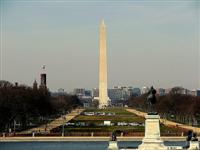
Extending for more than two miles (3km), from the US Capitol to the Potomac River, the tree-lined grassy strip known as the National Mall is the central hub of tourist activity in Washington DC, containing many of the city's most famous attractions. It is home to the tapering Washington Monument; the Lincoln, Roosevelt and Jefferson Memorials; the Capitol building; the White House; the museums of the Smithsonian Institution; and the National Gallery of Art.The Mall is at the heart of the city's social life, the site for many celebrations and festivals throughout the year, and used by scores of joggers, picnickers, food vendors, and strollers daily. It is also a popular site for rallies and protests ranging from a few dozen to a few million people. The Tidal Basin, a beautiful lake famous for the blossoming Japanese cherry trees in spring, lies to the south.
Website : www.nps.gov/nama
Telephone : (202) 426 6841 (Visitor information)
Transport : Smithsonian metro station
Opening times : The park is open 24 hours daily.
Admission : Free.

The Smithsonian National Zoological Park, commonly known as the National Zoo, is a wonderful attraction for families on holiday in Washington DC. As part of the Smithsonian Institution, the zoo has no entry fee and offers visitors the chance to explore 163 acres of habitats containing more than 1,800 animals, a fifth of which are endangered. The star attractions of the zoo are definitely the giant pandas. Other popular exhibits include the Great Ape House, Elephant Trails, Lion/Tiger Hill, Cheetah Conservation Station, and Seals and Sea Lions Exhibit. The National Zoo was the home of the original Smokey Bear, who was a symbol of forest fire prevention and lived at the zoo from 1950 to 1976.
Address : Rock Creek Park, 3001 Connecticut Avenue NW
Website : nationalzoo.si.edu
Telephone : (202) 633 4888
Transport : Metrorail Red line to Cleveland Park station. Metrobus lines L1, L2, and L4 stop at the Zoos Connecticut Avenue entrance, and H4 stops at the Harvard Street entrance.
Opening times : 8am to 7pm, last admittance at 6pm.
Admission : Free.
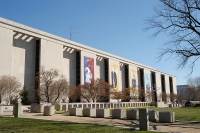
Nicknamed the nation's attic, the Smithsonian Institution is one of the world's finest research centres, incorporating 19 excellent museums, nine research centres, and a zoo spread over Washington DC, New York, Virginia, and Panama. Most of the museums are located in Washington DC. The centre was the brain-child of British scientist James Smithson who stipulated in his will that lacking heirs, his entire fortune would go the United States 'to found at Washington, under the name of the Smithsonian Institution, an establishment for the increase and diffusion of knowledge among men'. The Institute's original home was in the red brick building known as The Castle that stands on the Mall. The need to accommodate facilities for scientific research as well as housing all the science and art collections amassed resulted in the construction of more buildings along the Mall. Today the Castle houses the Smithsonian Information Center, which provides an overview of all the museums and the zoo.The museums contain collections of historical importance on almost every subject. Museums include the National Air and Space Museum, packed with full-size space and aircraft, including the Wright brothers' plane; the Natural History Museum, with the Hope Diamond and the world's largest stuffed blue whale; and the American History Museum, displaying the original Kermit the Frog. Other museums include the Freer and Sackler Galleries of Asian Art, the African Art Museum, the American Indian Museum, the Arts and Industries Building hosting changing exhibitions, the Hirshborn collection of modern art, the National Portrait Gallery, and the National Postal Museum.The Smithsonian Museums are a fantastic attraction for families in Washington DC, and a wallet-friendly one as admission is free.
Address : Smithsonian Castle Visitor Center, 1000 Jefferson Drive
E-mail : [email protected]
Website : www.si.edu
Telephone : (202) 633 1000
Transport : Smithsonian metro station. The DC Circulator bus provides transportation between the museums.
Opening times : Opening times vary depending on the museum - see the official website for details.
Admission : All museums are free.
Situated on the top of Capitol Hill, with its giant white dome visible from all over the city, is the US Capitol, the heart of US government and Washington DC's most prominent landmark. It is one of the city's top tourist attractions, as well as one of the most recognised symbols of democracy in the world, and contains the Senate and the House of Representatives, as well as the Supreme Court and the Library of Congress, the largest library in the world. Under the magnificent dome, US governmental policy is shaped and the law of the land is practiced.The interior is richly embellished, with hundreds of statues filling Statuary Hall in honour of important people in the country's history, while paintings and murals decorate the hallways and walls of the Rotunda, depicting 400 years of American history. The enormous circular hall capped by the 180-foot (55m) high dome is the hub of the Capitol, with a symbolic fresco masterpiece at its centre. The Rotunda links the north and south wings, the two halves of the Capitol that contain the Senate and House of Representatives respectively, and flags flying over either wing indicate which part of Congress is in session.
Address : East Capitol Street NE & First Street SE
Website : www.visitthecapitol.gov
Telephone : (202) 226 8000
Transport : Union Station Metro, Federal Center NW or Capitol South stations are all within walking distance
Opening times : The Capitol Visitor Center is open to visitors from 8.30am-4.30pm.
Admission : Free.
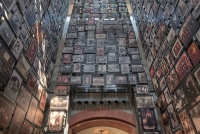
A living memorial to the Holocaust, the US Holocaust Memorial Museum hauntingly commemorates the abuse and murder of millions of Jews by the Nazis between 1933 and 1945. The permanent exhibition is divided into three floors, starting with the Nazi occupation of Poland, the Holocaust, and finally the after-effects of the war and liberation of the camps, with a moving film in which Holocaust survivors recount their personal experiences. The Hall of Remembrance is a quiet place of reflection, filled with dozens of burning candles lit in memory of the victims.Exhibits vividly convey the scale and nature of the horrors of the Holocaust using films, voice recordings, personal belongings of Jewish victims, photographs, and Nazi propaganda. The permanent exhibition's graphic content can be disturbing and is not recommended for children under 11 years of age. A different section of the museum contains an exhibit designed for children, called 'Daniel's Story: Remember the Children'.
Address : 100 Raoul Wallenberg Place
Website : www.ushmm.org
Telephone : (202) 488 0400
Transport : Smithsonian metro station
Opening times : Daily 10am to 5.20pm.
Admission : Entry is free year-round, but between March and August timed passes are required for the permanent exhibition. These passes can be booked in advance through the official website.
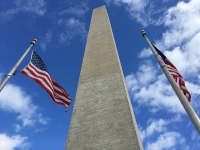
In recognition of his leadership in the fight for American independence, the Washington Monument was built to commemorate the 'Father of the Nation' and the first president of the United States, George Washington. As the tallest structure in the city, situated at the western end of the Mall, the gleaming white obelisk offers 360-degree panoramic vistas with some of the most familiar sights in the world in view, including the White House, US Capitol, Smithsonian museums, and the Lincoln Memorial.Constructed out of loose granite blocks without the use of cement to hold them together, the monument is the tallest freestanding masonry structure in the world, a 555-foot (169m) marble obelisk that stood uncompleted for 37 years. A change in the colour of stone is visible about halfway up and marks the two building phases. In 1888 a steam elevator transported visitors to the top, a 20-minute ride that was restricted, for safety reasons, to men only. Women could walk up the 897 stairs. Today climbing the steps is prohibited, but a free elevator conveys visitors to the gallery that provides unparalleled views of Washington DC and across the Potomac River.
Address : 2 15th Street and Constitution Avenue, NW
Website : www.nps.gov/wamo
Telephone : (202) 426 6841
Transport : Smithsonian metro station
Opening times : Open daily 9am-10pm.
Admission : Although admission is free, a ticket is required to enter the monument and ascend to the top. Advance ticket reservations are subject to a small fee per booking.
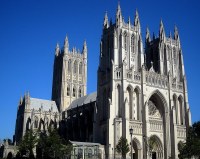
One of the largest cathedrals in the US, the Washington National Cathedral, also known as the Cathedral Church of Saint Peter and Saint Paul, is a magnificent Neogothic structure standing 301 feet (91m) tall. The interior of the cathedral is just as grand, with the long, narrow sanctuary framed by buttresses, chancels, transepts, and beautiful stained glass windows. The most famous of these is the Space Window, which contains a piece of moon rock brought back by Neil Armstrong from the Apollo 11 mission. The cathedral was finished in 1972, making it relatively young compared to most cathedrals of its stature. It is the final resting place of noted figures such as Helen Keller, President Woodrow Wilson and his wife, and Admiral George Dewey.
Address : 3101 Wisconsin Avenue NW
E-mail : [email protected]
Website : www.nationalcathedral.org
Telephone : (202) 537 6200
Opening times : Visiting hours vary depending on the day and the planned church services - check the official website for details. Guided tours are conducted at 10.15am Monday to Saturday and at 1pm on Sunday.
Admission : $12 adults, $8 children aged 5 - 17. Visits for worship, prayer, or religious services are free.
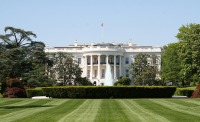
The White House has been the private residence and administrative headquarters of every President of the United States since 1800. Today an American flag flies over the house whenever the president is in residence. Situated at the edge of the National Mall, the palatial building has undergone numerous alterations over the years, which have included refurnishing and expansion, the addition of the first toilets by Jefferson, and electricity added during Harrison's presidency, as well as personal inclusions by each of its presidential occupants. The White House was adapted to the needs of Franklin D. Roosevelt who suffered polio and a swimming pool was installed; Jacqueline Kennedy developed the famous Rose Garden; Clinton added a jogging track, hot tub and humidor; and the most recent addition is the vegetable garden planted by Barack and Michelle Obama.Tours visit several rooms on the Ground and State Floors, including the Oval Office, the State Dining Room with seating for 140 dinner or luncheon guests, and the Gold and White East Room that is the publicised scene of presidential receptions and other social events. The top two floors are private. The visitor centre provides interesting historical information about the residence and its occupants. The custom that allows free public tours of the president's private home is only stopped during wartime.Security is understandably very tight and travellers wanting to visit will need to provide personal details in their application through the appropriate Washington DC embassy.Free guided tours are the only means of exploring the White House. American citizens can book these tours through their Member of Congress and foreigners must book through their embassy in Washington DC. Tours should be booked as far in advance as possible.
Address : 1600 Pennsylvania Avenue NW
Website : www.whitehouse.gov
Telephone : (202) 456 1414
Transport : McPherson Square, Federal Triangle or Metro Center metro stations
Opening times : Tuesday to Thursday 7.30am-11.30pm, Friday to Saturday 7.30pm-1.30pm, closed Monday and Sunday.
Admission : Free.

01474 814411

Travel Guide powered by Word Travels, copyright © 2023 Globe Media Ltd. By its very nature information in this travel guide is subject to change at short notice and travellers are urged to verify information on which they're relying with the relevant authorities. Neither Globe Media Ltd nor Travel Vogue can accept any responsibility for any loss or inconvenience to any person as a result of information contained above.